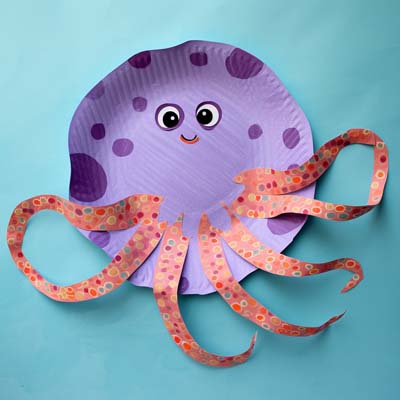DLTK's Crafts for Kids
Paper Plate
Octopus Craft
Contributed by Leanne Guenther


This adorable octopus craft uses a paper plate to make a project suitable for an animals theme, ocean theme, a number 8 theme, a letter O theme or just for fun.
Get ready to dive into the creative world of ocean creatures with this paper plate octopus craft tutorial. With just a few simple steps, you'll be able to craft a colorful and charming octopus. Let's get started!
Materials:
- Paper plate
- Paints (various colors)
- Construction paper
- Paintbrush
- Markers
- Scissors
- Glue or adhesive tape
Instructions:
- Paint the Paper Plate:
- Take a paper plate and choose your desired colors for the octopus.
- Use the paintbrush to cover the front side of the plate with vibrant colors.
- You can go for a single color or create a pattern using different colors.
- Make sure to paint the entire front surface of the plate.
- Set it aside to allow the paint to dry completely.
- Draw the Octopus Face:
- Once the paint has dried, use markers to draw a friendly face on the center of the paper plate.
- You can create big, expressive eyes, a smiling mouth, and any other details you'd like to add. You can use googly eyes instead of drawing them on or you can make your own googly-type eyes from a circle of white paper with a black center drawn on with marker.
- Feel free to get creative and personalize your octopus's expression.
- Cut out the Tentacles:
- Take the scissors and cut the paper plate into eight long, triangular shapes.
- Each tentacle should start from the edge of the plate and extend outward.
- Make sure the tentacles are long enough to create a playful effect.
- Keep in mind that the shape doesn't have to be perfect; uneven edges can add character.
- Attach the Tentacles:
- Apply glue or adhesive tape to one end of each tentacle cutout.
- Position the tentacles evenly around the backside (unpainted side) of the paper plate.
- Place them so that they stick out from the edge of the plate, resembling the octopus's tentacles.
- Press them down firmly to ensure they adhere securely.
- Decorate and Personalize:
- This step is optional but can add extra flair to your octopus.
- Use markers, paints, or other decorative materials to add patterns, spots, suckers or even glitter to the octopus's tentacles and body.
- Let your imagination guide you as you bring your octopus to life with colorful and playful details.
- Let it Dry and Display:
- Allow your octopus craft to dry completely, ensuring that all the elements are securely attached.
- Once dry, your paper plate octopus is ready to be displayed!
- You can hang it up on a wall, attach a string to create a hanging decoration, or use it as a playful centerpiece for an ocean-themed event.
Congratulations on creating a delightful paper plate octopus! This craft allows you to explore your creativity while bringing the beauty of the ocean to life. Enjoy the process of painting, drawing, and assembling your octopus. Let your imagination soar as you add personal touches and give your octopus a personality of its own.
Octopuses are incredibly diverse in their coloration, and they have the remarkable ability to change colors and patterns to camouflage themselves or communicate. Here are some of the colors and patterns you may find in octopuses:
- Brown: Many octopuses exhibit shades of brown, ranging from light tan to dark brown.
- Red: Some octopuses have reddish tones in their skin, which can vary from a light pinkish-red to a deep crimson.
- Orange: Certain species of octopuses showcase vibrant orange colors in their skin.
- Yellow: Some octopuses display yellow hues, ranging from pale yellow to a more vivid and intense shade.
- Blue: While not as common as other colors, some octopuses can exhibit blue pigmentation, often seen in patterns or spots.
- Green: Green is another color observed in octopuses, particularly in shades of olive green or emerald green.
- Mottled or Camouflage Patterns: Octopuses are masters of camouflage and can adopt mottled patterns with various colors to blend into their surroundings. They can imitate the colors and textures of rocks, corals, and even other marine organisms.
It's important to note that octopuses can change their coloration and patterns dynamically, allowing them to adapt to different environments or express their emotions. Therefore, their coloration can vary depending on factors such as their mood, surroundings, and interactions with other octopuses.
Print friendly version of these instructions